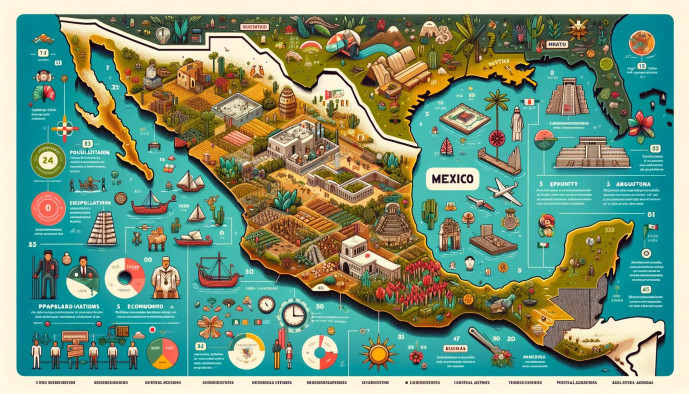Key Facts of Mexico
Explore Mexico's vibrant culture, bustling economy, political landscape, and diverse populace.

General Information
Official Name
The country is officially known as the United Mexican States, or Estados Unidos Mexicanos in Spanish.
Capital City
The nation’s capital is Mexico City, referred to locally as Ciudad de México and often abbreviated as CDMX.
Population
Mexico is home to nearly 130 million people, based on 2023 estimates, making it one of the most populous countries in the world.
Geography
Positioned in the southern part of North America, Mexico’s geography is diverse and expansive. It shares a long border with the United States to the north, and with Belize and Guatemala to the southeast. The country boasts magnificent and extensive coastlines along the Pacific Ocean to the west and the Gulf of Mexico and Caribbean Sea to the east.
Language
Official Language
Spanish is the de facto official language and is spoken by the vast majority of the population. It is worth noting that, at the federal level, Mexico’s constitution does not legally establish a single official language, thereby protecting its linguistic heritage.
Indigenous Languages
A testament to its rich pre-Hispanic history, Mexico formally recognizes 68 distinct indigenous languages. Among the most widely spoken are Nahuatl (the language of the Aztecs), Yucatec Maya, and Mixtec.
English Proficiency
In major tourist destinations such as Cancún, Los Cabos, and Mexico City, as well as in most hotels and airports, English is widely spoken and understood. However, venturing outside these zones, you will find that a few basic Spanish phrases are not only useful but also warmly appreciated by locals.
Time Zones
Multiple Zones
Navigating Mexico’s vast territory requires an awareness of its time zones, especially for those traveling across the country by land. The country is divided into four primary time zones.
- Zona Sureste (Southeast Zone): Covers the state of Quintana Roo, including popular destinations like Cancún, Playa del Carmen, and Tulum. This zone corresponds to Eastern Standard Time (EST).
- Zona Centro (Central Zone): This is the largest zone, encompassing most of the country and major cities like Mexico City, Guadalajara, and Monterrey. It corresponds to Central Standard Time (CST).
- Zona Pacífico (Pacific Zone): This zone includes states such as Baja California Sur, Sinaloa, and Nayarit. It corresponds to Mountain Standard Time (MST).
- Zona Noroeste (Northwest Zone): Covering the state of Baja California, this zone corresponds to Pacific Standard Time (PST).
Daylight Saving Time
It is critical to note that as of 2022, the vast majority of Mexico has eliminated the observance of Daylight Saving Time. The primary exception is a number of municipalities located along the northern border, which may still adjust their clocks to remain synchronized with their counterparts in the United States.
Government & Religion
System of Government
For context, Mexico operates as a Federal Presidential Republic, a system composed of 32 federal entities: 31 states and the capital, Mexico City.
Predominant Religion
Roman Catholicism is the dominant religion in Mexico. Its influence is deeply woven into the country’s culture, traditions, and public holidays, many of which are celebrated with vibrant and significant festivities.
Practicalities
Electrical System
Understanding the local electrical system is essential for keeping your devices charged.
- Voltage: 127 V
- Frequency: 60 Hz
- Plug Type: Type A (two flat parallel pins) and Type B (three pins, with a grounding pin).
Travelers from the United States, Canada, and Japan will find their plugs are compatible and will not require an adapter. Visitors from other regions will need a plug adapter. Please check your electronics to ensure they are dual-voltage (e.g., “100-240V”). If not, you will also need a voltage converter to prevent damage to your devices.
Tipping (Propina)
While not a “fact” in the traditional sense, understanding tipping customs is a key to navigating daily interactions. Known as propina, tipping is a deeply ingrained cultural norm.
- Restaurants: A tip of 10-15% of the total bill is standard practice. It is rarely included automatically, so be sure to check your receipt.
- Services: It is customary to offer small tips to hotel staff (bellhops, housekeeping), tour guides, and drivers for good service.
We highly recommend keeping a supply of small-denomination peso bills on hand, as this makes tipping for various services much more convenient.
Could not load FAQs. Please try again later.